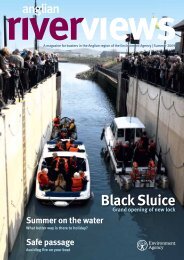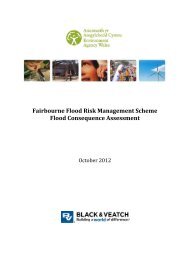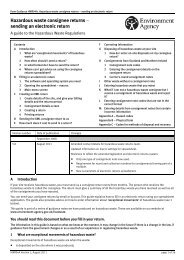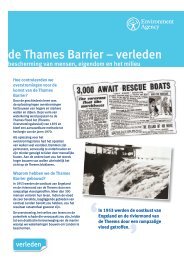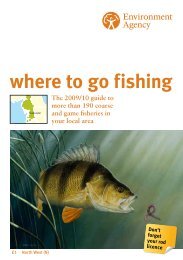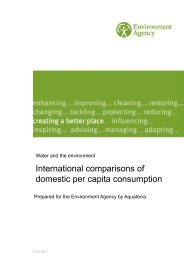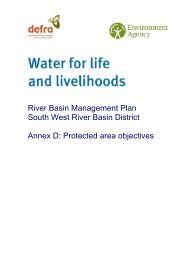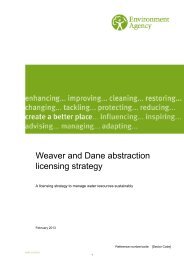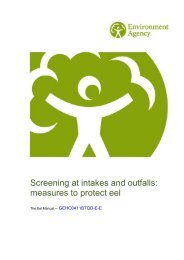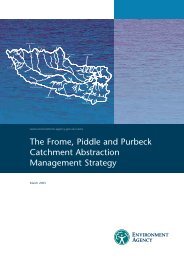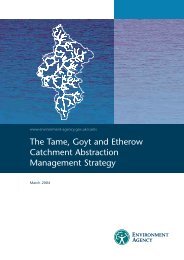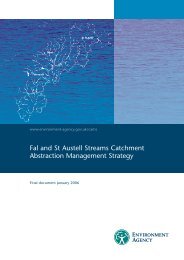Karenia mikimotoi
Karenia mikimotoi
Karenia mikimotoi
Create successful ePaper yourself
Turn your PDF publications into a flip-book with our unique Google optimized e-Paper software.
3.4.2 Effects on human health<br />
There are no reports that K. <strong>mikimotoi</strong> has affected human health via seafood<br />
poisoning. In reviewing the detrimental effects of G. aureolum (= K. <strong>mikimotoi</strong>) blooms<br />
Mahoney et al. (1990) commented:<br />
“The potential threats of G. aureolum blooms are not clear. An absence of documented<br />
poisoning of humans associated with the species suggests that a serious public health<br />
problem is unlikely”.<br />
Despite the wide range of toxic effects of whole cells and isolated compounds only two<br />
references in the literature to possible symptoms in humans caused by K. <strong>mikimotoi</strong><br />
have come to light. Blooms of Gyrodinium aureolum (= K. <strong>mikimotoi</strong>) occurred in New<br />
Jersey (USA) coastal waters in the summers of 1984 and 1985 (Mahoney et al., 1990).<br />
Cell concentrations in the bloom zones during the period of observation ranged from<br />
1.5–36 x 10 6 cells.L -1 (geometric mean 3.4 x 10 6 cells.L -1 ). These adverse effects on<br />
humans were noted:<br />
“Symptoms in humans coincidental with bloom exposure to the bloom water included<br />
nausea, sore throat, eye irritation and lung congestion (Marino, personal<br />
communication). Complaints were primarily from individuals, such as lifeguards, who<br />
had relatively extensive contact with the bloom water, or who were on the beaches for<br />
long periods when it was present.”<br />
The second reference was in the WHO guidelines (Anon., 2003) and is dealt with in<br />
sect. 5.<br />
An Environment Agency report from SW region, Cornwall division/area, dated 26 July<br />
2002, recorded a relatively low density bloom at Whitsand Bay, Tregonhawke, in which<br />
the major taxa were identified as Gyrodinium aureolum (11 x 10 3 cells.L -1 ) and<br />
Pseudonitzschia spp. (55 x 10 3 cells.L -1 ) and noted on the report form against ‘Evidence<br />
of toxic effect’, simply, “Yes, lifeguards falling ill.”<br />
A protracted bloom of <strong>Karenia</strong> <strong>mikimotoi</strong> occurred in summer 2005 along the northern<br />
half of the western Irish coastline. This bloom subsequently dissipated during the<br />
month of July and was then succeeded by a bloom of the same<br />
alga in the southwest in late July. The bloom was very intense and resulted in<br />
discolouration of seawater and foaming in coastal embayments. Major mortalities of<br />
benthic and pelagic marine organisms were observed and devastation of marine faunal<br />
communities was reported and observed in a number locations. Deaths of<br />
echinoderms, polychaetes and bivalve molluscs were observed in County Donegal and<br />
Mayo, while farmed shellfish and hatchery raised juvenile bivalve spat suffered<br />
significant mortalities along the Galway and Mayo coasts. Reports of dead fish and<br />
crustaceans were received from Donegal, Galway, West Cork and Kerry.<br />
The progress and effects of this exceptional bloom were observed and reported in<br />
great detail (Silke et al., 2005). No adverse effects on humans were reported (J. Silke,<br />
personal communication).<br />
During the persistent and extensive bloom of K. <strong>mikimotoi</strong> that occurred in Scottish<br />
waters in 2006, mortalities of marine fauna were attributed to the dinoflagellate, but<br />
there were no reports of effects on human health (Davidson et al., 2007; K. Davidson,<br />
personal communication).<br />
16 A Literature review of the potential health effects of marine microalgae and macroalgae



